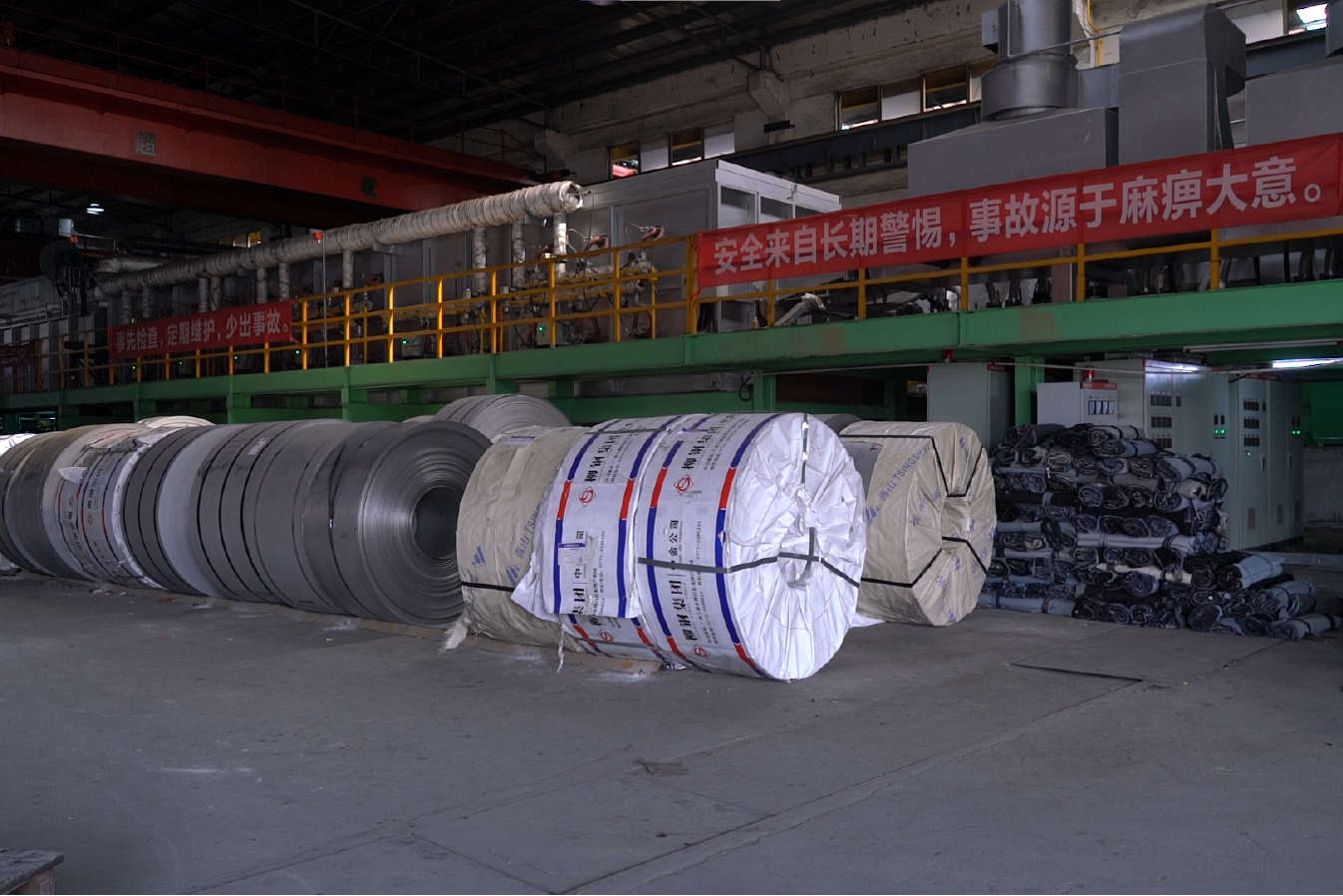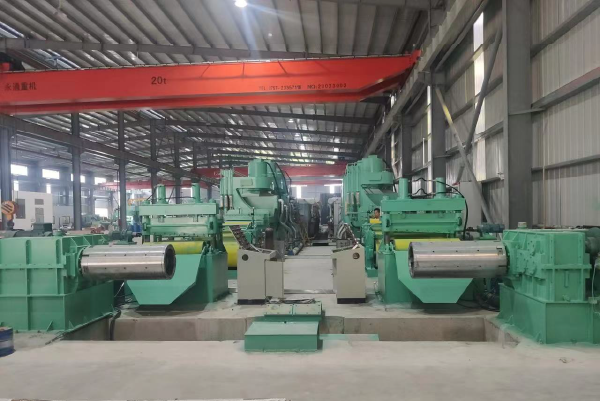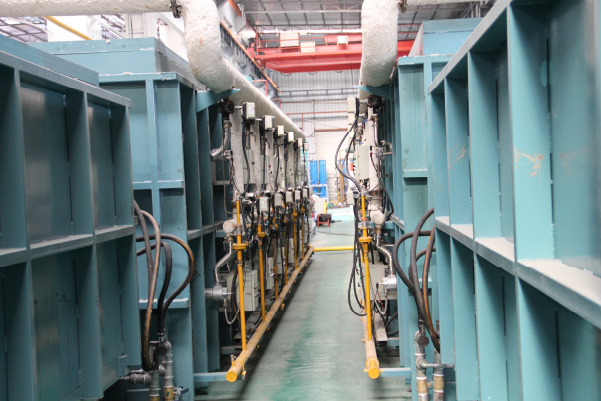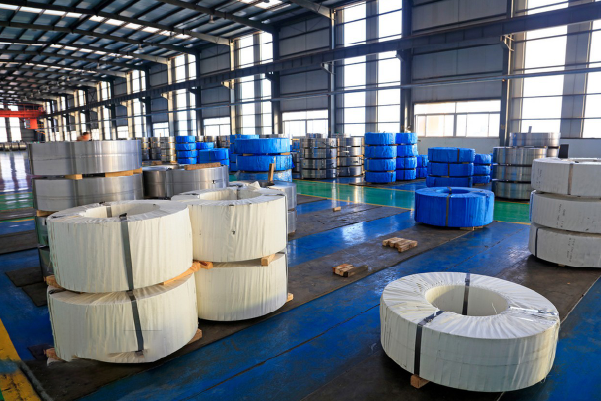Stainless Steel Coil Sizes & Weight Chart [PDF]

Are you struggling to accurately estimate material needs for your stainless steel projects? This uncertainty can lead to costly errors in procurement and logistical nightmares, derailing timelines. Our comprehensive Stainless Steel Coil Sizes & Weight Chart PDF is the solution, providing precise data for seamless planning.
A Stainless Steel Coil Sizes & Weight Chart PDF is an indispensable tool for professionals in the steel industry. It provides standardized data on coil dimensions, including thickness, width, and corresponding weights per unit length or per coil, crucial for accurate project planning, material estimation, and logistics.
Navigating the complexities of stainless steel coil specifications can be daunting, but it's a critical step for ensuring project success and cost-efficiency. As Global Business Director at MFY, I've seen firsthand how a clear understanding of these parameters can make or break a project. This guide aims to demystify this essential resource.
Understanding stainless steel coil sizes and weights isn't just about numbers; it's about optimizing your entire supply chain. From minimizing waste by ordering precise quantities to ensuring safe transportation and handling, the data from these charts has far-reaching implications. For instance, a manufacturing client in India recently shared how using our detailed MFY chart helped them reduce their usual material surplus by 7%, directly impacting their bottom line. This level of precision is what we strive to empower our clients with, whether they are large-scale manufacturers or specialized engineering contractors. Industry studies consistently show that accurate material specification can lead to significant cost savings, often ranging from 5-10% in overall project material costs. This deeper dive will explore how to effectively use these charts.
How to access the Stainless Steel Coil Sizes & Weight Chart PDF?
Are you tired of searching endlessly for reliable stainless steel coil data? This frustration often leads to using outdated or inaccurate information, risking project viability. Accessing a dependable chart, like those provided by MFY, ensures you have the correct specifications at your fingertips.
To access a Stainless Steel Coil Sizes & Weight Chart PDF, you can typically download it directly from reputable stainless steel manufacturers' or suppliers' websites, such as MFY. Industry associations and specialized metalworking portals also often provide access to these valuable resources for their members or the public.
Finding the right Stainless Steel Coil Sizes & Weight Chart PDF is the first crucial step towards accurate project planning and execution. In my role at MFY, I frequently interact with clients, from bustling manufacturing hubs in Southeast Asia to large-scale engineering projects in the Middle East, all of whom rely on precise data. The accessibility of this information can significantly impact their operational efficiency. Many of our clients, particularly distributors and traders, appreciate the ease with which they can obtain these charts from our website, www.mfysteel.com, as it allows them to quickly respond to their own customers' inquiries. We've made it a priority at MFY to ensure our charts are not only comprehensive but also easily downloadable, reflecting our commitment to supporting our clients' needs. This commitment extends beyond just providing a product; it’s about providing a complete solution. A readily available and accurate chart empowers our clients to make informed decisions swiftly, which is paramount in today's fast-paced market. This ease of access can prevent costly delays and ensure that projects stay on schedule and within budget, a common concern for engineering and construction contractors we partner with.

Accessing a reliable Stainless Steel Coil Sizes & Weight Chart PDF is fundamental for anyone working with stainless steel. The methods for obtaining these charts vary, but the goal remains the same: to secure accurate data for informed decision-making. As we delve deeper, we'll explore the primary channels, the importance of supplier-specific data, and how digital advancements are making access easier than ever. At MFY, we understand that our clients, whether they are large manufacturing companies or specialized equipment integrators, need quick and reliable information. I recall a specific instance with an equipment integrator in Russia who was on a tight deadline for a custom fabrication project. They needed immediate confirmation on specific coil weight capacities for their machinery. Being able to quickly download our MFY chart allowed them to verify their calculations and proceed without delay, highlighting the practical value of easily accessible resources. This is not just about providing a PDF; it's about facilitating efficiency and confidence in our clients' operations. The digital age has revolutionized how this information is disseminated. While printed charts were once the norm, online PDFs offer unparalleled convenience, allowing for instant access and updates. This shift is particularly beneficial for our international clients, who can access MFY's resources regardless of their geographical location or time zone.
Direct Download from Reputable Suppliers like MFY
One of the most common and reliable ways to obtain a stainless steel coil size and weight chart is directly from the websites of established manufacturers and suppliers. Companies like MFY, deeply rooted in the stainless steel industry, typically provide these resources as part of their customer support and informational offerings. We believe that empowering our clients with accurate data is a cornerstone of a strong business relationship. For example, our website, www.mfysteel.com, features a dedicated section where clients can download charts for our stainless steel coils, sheets, and pipes. This direct access ensures that the information is current and reflective of the specific product grades and dimensions we offer.
This direct approach offers several advantages. Firstly, the data is likely to be highly accurate for the supplier's specific products, as it aligns with their manufacturing capabilities and stock. This is crucial for clients like manufacturing companies who need precise specifications for their production lines. Secondly, suppliers often update these charts regularly to reflect new product offerings or changes in industry standards. I remember a case where a long-term manufacturing client in India almost used an outdated generic chart for a critical order. Luckily, they cross-referenced with MFY's latest PDF, which included a newly available coil width that perfectly optimized their cutting process, saving them significant material waste.
Furthermore, downloading from a supplier like MFY can often lead to further support. If there are any ambiguities or if a client requires information not explicitly stated in the chart (perhaps for a custom order), they have a direct line of communication with our expert team. This was particularly helpful for an engineering contractor working on a project with unique structural requirements in the Middle East. They downloaded our standard chart but then contacted us to discuss custom coil specifications, which we were able to accommodate due to our integrated supply chain and production flexibility. This synergy between readily available information and expert support is what we aim for at MFY.
Industry Association Websites and Portals
Beyond individual suppliers, many national and international steel industry associations provide comprehensive resources, including standardized coil size and weight charts. Organizations such as the World Steel Association, or regional bodies like the European Steel Association (EUROFER) or the American Iron and Steel Institute (AISI), often publish guidelines and data that serve as industry benchmarks. These resources are invaluable for obtaining a broader understanding of generally accepted standards and practices within the global steel market. For companies operating across different regions or sourcing from multiple suppliers, these association-provided charts can offer a useful baseline for comparison.
The information from these portals is generally well-researched and vetted by industry experts, lending it a high degree of credibility. This is particularly useful for distributors and traders who need to understand the typical range of products available in the market to serve their diverse clientele effectively. However, it's important to note that these charts might be more generic than supplier-specific ones. While they provide excellent general guidance, for precise procurement related to a specific supplier's product, like MFY's stainless steel coils, it's always advisable to use the chart provided by that supplier to ensure exact dimensional and weight accuracy.
Moreover, accessing charts through industry associations can also provide insights into broader market trends, material grade specifications, and sometimes even regulatory compliance information relevant to stainless steel. For instance, an equipment integrator looking to ensure their designs meet international material standards might find these portals extremely useful. While MFY focuses on providing detailed charts for our specific product lines, we often guide our clients to these reputable industry resources for supplementary information, ensuring they have a well-rounded understanding of the stainless steel landscape. This collaborative approach helps build a more informed and efficient industry.
Requesting Custom Charts for Specific Needs
In some instances, standard downloadable charts may not cover the unique requirements of a particular project or application. This is where the ability to request custom charts or specific data calculations from a supplier like MFY becomes crucial. Many of our clients, particularly those in specialized manufacturing or complex engineering and construction projects, often have needs that go beyond standard stock sizes. They might require coils with non-standard widths, specific inner diameters, or even unique weight limitations due to handling equipment constraints.
At MFY, our customer-centric approach means we are equipped to handle such requests. Thanks to our integrated supply chain, from raw material trading and cold-rolled processing to tube manufacturing, we have the flexibility and technical expertise to discuss and potentially produce coils to custom specifications. When a client approaches us with such a need, our technical sales team works closely with them, leveraging our production insights to determine feasibility and provide accurate weight and dimension data for their unique requirements. For example, a client in Southeast Asia involved in manufacturing specialized automotive components needed coils of a very specific, non-standard thickness and width to minimize processing steps. We were able to provide them with a custom specification sheet and subsequently supply the material, significantly enhancing their production efficiency.
This personalized service extends beyond just providing numbers; it involves a consultative process. We discuss the application, understand the constraints, and then provide data that is not just accurate but also optimized for their specific use case. This capability is a direct result of MFY's commitment to innovation-driven development and our vision to be a leading international trade and service brand. For businesses that require this level of customization, direct engagement with a knowledgeable and flexible supplier is often the most effective way to obtain the precise coil data they need, ensuring their projects are successful and their material use is optimized.
Accurate charts can reduce material wasteTrue
The text provides examples where using precise charts helped clients reduce material surplus by 7% and achieve 5-10% cost savings.
Printed charts are more reliable than PDFsFalse
The text states that online PDFs offer superior convenience and can be updated more easily than printed charts, making them more practical for modern use.
What information is typically included in a stainless steel coil size chart?
Are you unsure what critical data a stainless steel coil size chart1 should contain for your planning? Overlooking key details can lead to miscalculations and procurement errors. A comprehensive chart, like those from MFY, clearly outlines all essential parameters.
A typical stainless steel coil size chart includes crucial information such as material grade (e.g., 304, 316L), thickness, width, and often the inner diameter (ID) and outer diameter (OD) range, along with calculated weight per unit of width/length or total coil weight.
Understanding the array of information presented in a stainless steel coil size chart is pivotal for anyone involved in the procurement, design, or fabrication processes using these materials. As someone who interacts daily with manufacturers, contractors, and distributors globally, I've seen how a comprehensive chart can streamline operations and prevent costly mistakes. These charts are more than just tables of numbers; they are a blueprint for material specification. MFY ensures its charts are detailed, covering not only the basic dimensions like thickness and width, which are fundamental for any application, but also information on various stainless steel grades we offer. This allows clients, for example, an engineering contractor in the Middle East choosing between 304 for general purposes or 316L for higher corrosion resistance, to see how grade might affect weight and availability in certain sizes. Furthermore, details like coil ID are crucial for compatibility with processing machinery, a common concern for our manufacturing clients. The clarity and completeness of this information directly translate to efficiency in our clients' projects, reducing ambiguity and facilitating smoother workflows.

A well-structured stainless steel coil size chart is a vital tool, acting as a primary reference for engineers, purchasers, and production managers2. The data it contains goes beyond simple dimensions, often encompassing material properties and weight calculations crucial for logistical and structural planning. At MFY, we design our charts to be as comprehensive and user-friendly as possible, understanding that our diverse clientele, from large manufacturing companies in India to specialized equipment integrators in Russia, rely on this information for critical decisions. The typical components of such a chart are standardized to a degree, but the detail and precision can vary. We'll explore the core elements like grade, thickness, and width, and then delve into why aspects like coil ID/OD and weight calculations are indispensable. For instance, a distributor needs to know the weight per coil for shipping and storage calculations, while a manufacturer will be keenly interested in the precise thickness and width tolerances for their machinery. I recall a client in Southeast Asia who was able to optimize their warehouse space significantly by using the detailed coil OD and weight information from our MFY chart, allowing them to store more material efficiently. This kind of practical benefit underscores the importance of each piece of information included.
Core Dimensional Data: Grade, Thickness, and Width
The absolute bedrock of any stainless steel coil chart is the core dimensional data, primarily consisting of the material grade, thickness, and width. The stainless steel grade (e.g., 304, 316, 4303) is fundamental as it dictates the material's chemical composition, mechanical properties, corrosion resistance, and, consequently, its suitability for specific applications and its density, which affects weight. At MFY, we offer a variety of grades, and our charts clearly delineate the available sizes for each. For example, a client manufacturing kitchen appliances might opt for grade 304 due to its excellent formability and corrosion resistance, while another client in the chemical processing industry would require grade 316L for its superior resistance to corrosive agents. Our charts help them identify the available thickness and width options within their chosen grade.
Thickness is typically expressed in millimeters (mm) or inches, and it's a critical parameter for structural integrity, forming capabilities, and end-product specifications. MFY's charts provide a range of standard thicknesses, often with very tight tolerances, reflecting our precision cold-rolling processing capabilities. Width, also in mm or inches, defines the span of the coil. Standard widths vary, but common ones include 1000mm, 1219mm (4 feet), and 1500mm. Manufacturing companies often select widths that minimize waste during their cutting or stamping processes. I’ve worked with many clients, like a large automotive parts manufacturer, who rely on receiving coils of exact specified widths to fit their automated production lines. Any deviation can cause significant disruptions, which is why accurate chart data, backed by reliable supply, is paramount.
The interplay between grade, thickness, and width determines the initial suitability of a coil for a project. For instance, a construction contractor might need a thicker gauge of a corrosion-resistant grade for outdoor structural elements, whereas an electronics manufacturer might require very thin, narrow coils of a specific grade for casings. MFY's charts are designed to allow for quick cross-referencing of these parameters. We’ve seen cases, particularly with clients in emerging markets like India and Southeast Asia, where access to a clear chart listing diverse options has enabled them to explore more cost-effective or better-performing material solutions than they initially considered, simply because the availability and specifications were clearly laid out. This transparency is a key part of our service.
Coil Geometry: Inner Diameter (ID) and Outer Diameter (OD)
Beyond the flat dimensions, the geometry of the coil itself is crucial, specifically its Inner Diameter (ID) and Outer Diameter (OD). The ID refers to the diameter of the hollow center of the coil, around which the steel is wound. This is a critical specification for compatibility with uncoiling and processing machinery, such as decoilers, slitters, and presses. Standard IDs commonly found in the industry are 508mm (20 inches) and 610mm (24 inches), and MFY supplies coils with these standard IDs to ensure they fit the equipment used by our diverse client base, from large manufacturing plants to smaller workshops. If a coil's ID doesn't match the processing equipment's mandrel, it can lead to significant setup delays or even the inability to use the material.
The Outer Diameter (OD) indicates the overall diameter of the wound coil. While the OD can vary depending on the coil's total weight and strip length, it's an important factor for several reasons. Firstly, it influences storage and handling logistics. Warehouse racking systems and material handling equipment (like cranes and forklifts) have limitations on the size and weight of coils they can accommodate. Secondly, the OD, in conjunction with the ID and material thickness, can be used to estimate the total length of the steel strip in the coil, which is vital for production planning. A client managing a continuous production line, for example, needs to know the approximate length to schedule coil changes and maintain workflow.
At MFY, we often provide typical OD ranges for given coil weights and widths, or the information needed to calculate it. I recall an instance with an equipment integrator client who was designing a compact processing line for a customer with limited space. They needed to ensure the OD of the stainless steel coils wouldn't exceed certain dimensions. By referring to our MFY chart and consulting with our team, they were able to confirm suitable coil specifications that met their spatial constraints. This highlights how geometric data like ID and OD, often overlooked, plays a significant role in the practical application and integration of stainless steel coils into manufacturing processes. Providing this comprehensive data is part of MFY's commitment to facilitating seamless operations for our clients.
Weight Specifications: Per Unit and Total Coil Weight
Weight specifications are arguably one of the most critical pieces of information found in a stainless steel coil chart, essential for logistics, cost estimation, and structural calculations. Charts typically provide weight in two main ways: weight per unit of length/area (e.g., kg per meter of length for a given width, or kg per square meter) and the total weight of the coil. The weight per unit is derived from the material's density (which varies slightly by grade), thickness, and width. This figure is invaluable for engineers calculating loads and for purchasers estimating the amount of material needed for a specific number of parts or a certain area of coverage.
Total coil weight is a crucial logistical parameter. Shipping costs are often based on weight, and handling equipment (cranes, forklifts) has specific weight capacities. Knowing the maximum and typical coil weights offered by a supplier like MFY allows clients to plan their receiving and internal logistics effectively. For our export markets, such as India, Southeast Asia, and Russia, accurate weight documentation is also vital for customs clearance and freight optimization. An MFY client, a large distributor in the Middle East, relies heavily on our accurate coil weight data to optimize container loads, thereby reducing their per-unit shipping costs. They've explicitly mentioned how the reliability of our stated weights, compared to some other sources, has saved them from unexpected freight charges.
Furthermore, understanding weight specifications helps in inventory management. By knowing the weight of incoming coils and the weight of processed parts, companies can track material consumption and yield accurately. MFY’s charts aim to provide clear and precise weight information, often including theoretical weight calculation formulas or direct weight values for standard coil sizes. This detailed information supports our target clients – manufacturing companies, engineering and construction contractors, distributors, and equipment integrators – in making sound financial and operational decisions. The table below illustrates a simplified example of how theoretical weight is generally presented or can be derived for a common grade like 304:
| Thickness (mm) | Width (mm) | Density (kg/m³) (Approx. for SS304) | Weight per meter (kg/m) | Typical Coil Weight Range (kg) for Standard OD |
|---|---|---|---|---|
| 0.5 | 1000 | 7930-8000 | ~3.97 - 4.00 | 3000 - 8000 |
| 1.0 | 1219 | 7930-8000 | ~9.67 - 9.75 | 5000 - 10000 |
| 2.0 | 1500 | 7930-8000 | ~23.79 - 24.00 | 8000 - 15000 |
Note: Actual weights can vary slightly due to manufacturing tolerances and exact density of specific heats. This data empowers clients to plan with greater accuracy.
Coil ID affects machinery compatibilityTrue
The inner diameter must match processing equipment's mandrel size to ensure proper uncoiling and material handling.
Weight data is only for shippingFalse
Weight specifications are crucial for structural calculations, cost estimation, and production planning beyond just shipping logistics.
How to interpret the size data presented in the chart?
Feeling overwhelmed by the numbers and codes in a stainless steel coil chart? Misinterpreting this data can lead to ordering the wrong materials, causing significant project setbacks. Learning to read these charts correctly, with guidance from MFY, is key to your success.
To interpret size data in a stainless steel coil chart, identify the material grade, then cross-reference the desired thickness and width. Note any specified tolerances, coil ID/OD, and corresponding weight information to ensure the product meets your project's precise requirements.
Interpreting the size data presented in a stainless steel coil chart accurately is a skill that underpins efficient material procurement and utilization. As Global Business Director at MFY, I've often guided clients, from rapidly growing manufacturing firms in Southeast Asia to established engineering contractors in Russia, through this process. It's not just about reading numbers; it's about understanding their implications for the project at hand. For instance, a seemingly minor difference in thickness tolerance can significantly affect the performance of a precision-engineered part. Our MFY charts are designed for clarity, but the nuances of industry-standard notations and the interplay between different parameters require careful attention. We encourage clients to look beyond just the nominal dimensions and consider aspects like specified tolerances for thickness and width, as these can impact processing and final product quality. Understanding these details ensures that the material ordered from MFY perfectly aligns with their operational needs and quality standards, preventing costly rework or material rejection, a scenario no business wants to face.

Effectively interpreting a stainless steel coil size chart is crucial for transforming raw data into actionable insights for your projects. These charts are dense with information, and each piece of data, from material grade to dimensional tolerances, has specific implications. At MFY, we strive to make our charts as intuitive as possible, but a foundational understanding of how to read them is essential for all our clients, whether they are experienced distributors or engineering firms new to specifying stainless steel coils. We'll explore how to navigate these charts, focusing on cross-referencing key parameters, understanding tolerances, and recognizing the significance of different specifications for various applications. For example, a construction contractor might prioritize specific strength characteristics tied to a grade and thickness, while a manufacturer of decorative panels might be more concerned with surface finish options available for certain coil sizes. I once worked with a client in India who was new to sourcing stainless steel coils directly. By walking them through our MFY chart and explaining how to interpret the interplay between grade, thickness, and available widths, they were able to select a more cost-effective option that still met all their performance criteria, something they wouldn't have identified on their own. This collaborative approach to data interpretation is something we value at MFY.
Cross-Referencing Thickness, Width, and Grade
The primary step in interpreting a stainless steel coil chart involves cross-referencing the three most fundamental parameters: material grade, thickness, and width. Users typically start by identifying the required stainless steel grade (e.g., 304, 316L, 430 stainless steel grades4) based on the application's demands for corrosion resistance, strength, formability, or temperature resistance. Once the grade is selected, the chart is then consulted to find available combinations of thickness and width for that specific grade. For instance, an MFY chart might show that for grade 304, thicknesses from 0.3mm to 3.0mm are available in standard widths like 1000mm, 1219mm, and 1500mm, while a more specialized grade like Duplex stainless steel might have a different range of available sizes.
This cross-referencing is not always a linear process. Sometimes, a desired thickness might only be available in certain widths, or a particular width might only be offered in a limited range of thicknesses for a specific grade. Manufacturing companies often have very specific requirements for both thickness (for product functionality) and width (to optimize their cutting and stamping processes and minimize scrap). I recall a client, an automotive component manufacturer, who needed a precise thickness of 0.8mm in grade 301 for its spring properties. By consulting our MFY chart, they could quickly identify the available widths for this specific thickness and grade, allowing them to select the option that best fit their production line and minimized material wastage. This ability to quickly find feasible combinations is a key benefit of a well-structured chart.
Furthermore, it’s important to understand that availability can also be a factor. While a chart might list a wide range of theoretical sizes, practical availability can depend on production schedules and stock levels. This is where direct communication with a supplier like MFY becomes invaluable. After identifying potential options from the chart, a quick consultation with our sales team can confirm current availability or discuss lead times for non-stock items. This proactive approach, combining chart interpretation with supplier dialogue, ensures that project timelines are realistic and material procurement is efficient, a practice we always recommend to our clients, including engineering and construction contractors who often work on tight schedules.
Understanding Tolerances and Specifications
Beyond the nominal dimensions of thickness, width, and length, understanding the specified tolerances is critical for accurate interpretation of a stainless steel coil chart. Tolerances define the permissible deviation from the stated nominal dimension. For example, a coil specified with a thickness of 1.0mm might have a tolerance of ±0.05mm, meaning the actual thickness can range from 0.95mm to 1.05mm. These tolerances are often governed by international standards (like ASTM, EN, or JIS standards5), but suppliers like MFY may also offer products with tighter tolerances based on their advanced production capabilities, such as our precision cold-rolling processes. For applications requiring high precision, such as in the manufacturing of electronic components or intricate machinery parts, these tolerances are paramount.
Interpreting tolerance data correctly ensures that the supplied material will be fit for purpose. If a manufacturing process requires extremely tight thickness control, selecting a coil based only on its nominal thickness without considering the tolerance range could lead to production issues or product defects. I've encountered situations where clients, particularly new equipment integrators, initially overlooked tolerance specifications, only to realize later that standard tolerances were insufficient for their high-precision application. By discussing their needs with MFY and carefully reviewing the tolerance data in our charts, they were able to select a product with a more suitable, tighter tolerance, averting potential problems. Our charts clearly indicate applicable tolerance standards or specific MFY tolerances for our products.
Other specifications to note include edge conditions (e.g., mill edge, slit edge), surface finishes (e.g., 2B, BA, No.4), and any protective coatings if applicable. For example, a slit edge coil will have a more precise width tolerance compared to a mill edge coil. Similarly, the surface finish is critical for aesthetic applications or where specific surface properties are required. An architect specifying stainless steel for a facade will pay close attention to the surface finish options available for the chosen coil size and grade. MFY aims to provide comprehensive information on these specifications within our charts or accompanying documentation, ensuring our clients, from large-scale manufacturers to specialized fabricators, can make fully informed decisions.
Relating Chart Data to Specific Applications
The true value of interpreting a stainless steel coil chart lies in relating the data directly to the specific requirements of an application. Different industries and end-uses place varying importance on different parameters. For instance, a manufacturer of food processing equipment (a key target client for MFY) will prioritize specific grades like 304 or 316L for their hygiene and corrosion resistance, and will be particular about surface finish (e.g., a smooth 2B or polished finish for easy cleaning). They would use the chart to find coils meeting these grade and finish requirements in the necessary thicknesses for tanks, work surfaces, and piping. The weight data would also be crucial for designing support structures.
In contrast, an engineering and construction contractor working on a large infrastructure project in, say, the Middle East (one of MFY's export markets) might be more focused on structural grades, yield strength (often related to grade and thickness), and coil weights for logistical planning and crane capacity on site. They would use the chart to select appropriate thicknesses and widths for structural members, ensuring they meet engineering specifications, and also to estimate total tonnage for budgeting and shipping. The coil ID would be important if they are doing on-site decoiling and processing.
Distributors and traders, another of MFY's target client groups, use these charts extensively to manage their inventory and serve a broad customer base. They need to understand the range of common sizes, grades, and finishes that are in demand in their respective markets (e.g., India, Southeast Asia). They interpret the chart to stock a versatile range of coils, balancing popular items with potentially more niche specifications. I’ve often advised distributor partners on interpreting demand trends reflected in the types of inquiries they receive, and how that aligns with the standard offerings in our MFY charts, helping them optimize their stock. Ultimately, the ability to translate the numerical data from a chart into practical, application-specific material choices is what makes these documents so powerful.
Material grade determines available sizesTrue
Different stainless steel grades have varying ranges of available thicknesses and widths, as shown in the chart.
Tolerances are the same for all gradesFalse
Tolerances can vary by grade and manufacturer, with some offering tighter tolerances than standard specifications.
How to calculate the weight of a stainless steel coil using the chart?
Are you struggling with inaccurate weight estimations for your stainless steel coils, leading to budget overruns or logistical issues? Complex calculations can be daunting. MFY's charts often provide direct weight information or the necessary data for straightforward calculation.
To calculate stainless steel coil weight using a chart, you'll typically find pre-calculated weights per unit (e.g., kg/mm of width/meter of length) or total coil weights. Alternatively, use the density (provided or standard for the grade), thickness, width, and length (if known or calculable from ID/OD in the formula: Weight = Density × Thickness × Width × Length.
Calculating the weight of a stainless steel coil accurately is a fundamental requirement for budgeting, logistics, and structural design. In my capacity at MFY, I’ve seen how precise weight calculations empower our clients, whether they're planning shipments to India or designing machinery in Russia. While many charts, including ours, provide direct weight listings for standard coil sizes, understanding the underlying calculation method is beneficial. This knowledge allows for estimations even for non-standard lengths or for verifying listed weights. The core factors are the material's density (which varies slightly between different stainless steel grades), its thickness, width, and the total length of the strip in the coil. For clients like engineering and construction contractors, accurate weight calculations are non-negotiable for ensuring structural integrity and safe lifting operations. MFY supports this by providing clear density values for our grades or by incorporating easy-to-use weight per meter data in our charts.

Accurately determining the weight of a stainless steel coil is a critical step in many industrial processes, from procurement and shipping to manufacturing and installation. While some charts provide direct total coil weights for standard configurations, understanding how to calculate it or use per-unit weight data is essential for flexibility and verification. At MFY, we aim to simplify this for our clients, but a deeper comprehension of the factors involved—density, dimensions, and coil geometry—is always advantageous. This section will break down the common methods for weight calculation using chart data, explore the importance of material density, and discuss how coil geometry (ID/OD) can be used to estimate strip length for more precise weight calculations. I've worked with numerous manufacturing companies and distributors who have benefited from a clearer understanding of these calculations, enabling them to optimize freight costs and inventory management. For example, a distributor in Southeast Asia was able to more accurately forecast their shipping container requirements by applying these principles to mixed batches of coils from MFY, leading to tangible cost savings.
Utilizing Direct Weight Data and Weight-Per-Unit-Length
The most straightforward way to determine coil weight using a chart is by referencing directly provided weight data. Many comprehensive charts, like those MFY strives to provide, will list a "Total Coil Weight" or "Approximate Coil Weight" for standard combinations of grade, thickness, width, and a typical Outer Diameter (OD) or build-up. This is particularly useful for quick estimations and for standard stock items. For instance, a chart might state that a 1.0mm thick, 1219mm wide coil of grade 304 with a standard 508mm ID and a typical OD of 1500mm weighs approximately X kilograms. This allows purchasers and logistics planners to quickly assess material handling requirements and shipping costs.
Alternatively, and often more flexibly, charts provide "Weight per Unit of Length" (e.g., kg/meter for a given width and thickness) or "Weight per Unit of Area" (e.g., kg/m² for a given thickness). To use this, you would first identify the relevant material (grade, thickness, width) and find its corresponding unit weight. If you know the total length of the steel strip required or present in the coil, you simply multiply this length by the weight per unit of length. For example, if a chart indicates that a 0.8mm thick, 1000mm wide stainless steel strip weighs 6.4 kg/meter, and you have a coil containing 500 meters of this strip, the total weight would be 6.4 kg/m * 500 m = 3200 kg. This method is highly favored by manufacturing companies that consume specific lengths in their production runs.
At MFY, we ensure our charts provide this unit weight data or the necessary parameters (like density) to easily calculate it. This empowers our clients, including equipment integrators who need to factor in component weights for their designs, to make precise calculations. I recall a client in Russia who was designing a specialized processing machine; using the weight-per-meter data from our MFY chart allowed them to accurately calculate the load on various machine components that would handle the uncoiling process, ensuring a robust and safe design. This direct or unit-based approach significantly simplifies the weight estimation process for many common scenarios.
The Role of Density in Weight Calculation
The density of the stainless steel is a fundamental physical property crucial for accurate weight calculation, especially when direct weight listings are unavailable or when verifying chart data. Density is defined as mass per unit volume and is typically expressed in kilograms per cubic meter (kg/m³) or pounds per cubic inch (lb/in³). Different grades of stainless steel have slightly different densities due to variations in their alloying elements (e.g., chromium, nickel, molybdenum)6. For example, austenitic grades like 304 and 316 generally have densities around 7900-8000 kg/m³, while ferritic grades like 430 might be slightly less dense, around 7700-7800 kg/m³. MFY charts or accompanying technical datasheets will specify the appropriate density for the grades offered.
The basic formula to calculate the weight of a flat piece of steel (which a coil essentially is, unrolled) is: Weight = Volume × Density. The volume of the steel strip is calculated as Volume = Thickness × Width × Length. Therefore, the comprehensive formula becomes: Weight = Thickness × Width × Length × Density. It's crucial that all units are consistent before performing the calculation (e.g., all dimensions in meters, density in kg/m³, to get weight in kg). Forgetting to convert units is a common source of error. For example, if thickness is in millimeters, it must be converted to meters by dividing by 1000.
Understanding the impact of density is important. Even a small variation in density between different assumed values and the actual material can lead to noticeable differences in calculated weight for large coils. This is why relying on supplier-provided density values for specific grades, such as those from MFY for our stainless steel coil products, is recommended for the most accurate results. This precision is valued by all our client types, from manufacturing companies needing accurate material input weights for process control, to engineering and construction contractors who depend on precise load calculations for structural elements. A minor error in density for a large tonnage project could lead to significant discrepancies in overall weight and cost.
Calculating Weight from Coil Dimensions (ID, OD, Width, Thickness)
When the total length of the steel strip in a coil is not directly known, it can be estimated using the coil's geometric dimensions: Inner Diameter (ID), Outer Diameter (OD), width, and thickness of the strip. This method is more complex but provides a good approximation of the coil's weight. The first step is to calculate the cross-sectional area of the steel in the wound coil. This is found by taking the area of the full circle (using OD) and subtracting the area of the hollow center (using ID), then multiplying by a factor that accounts for the fact that it's a wound strip, not a solid cylinder (this factor is often simplified or built into specific formulas). A more practical approach involves calculating the number of wraps and then the average length per wrap.
Alternatively, a common formula to estimate the length (L) of the strip in a coil is:
L = π × (OD² - ID²) / (4 × Thickness × 1000) (if OD, ID are in mm, Thickness in mm, for Length in meters. The factor 1000 in denominator converts thickness to meters if OD/ID are in mm, or it can be adjusted based on consistent units). More accurately, the volume of steel in the coil is Volume_steel = (π/4) × (OD² - ID²) × Width.
Then, Weight = Volume_steel × Density.
This calculation for Volume_steel assumes the coil is a solid cylinder of steel with a hole in it.
A more precise formula for the length (L) based on the cross-sectional area of the strip is:
*L = [π ( (OD/2)² - (ID/2)² )] / Thickness** (This calculates the total cross-sectional area of metal on the coil face and divides by thickness to get length. Ensure consistent units). Once length L is found, Weight = L × Width × Thickness × Density.
Let's use a standard formula for weight based on these dimensions:
Weight (kg) = [(OD² - ID²) × Width × Density × π] / [4 × 10⁶]
Where OD, ID, Width are in mm, Density in kg/m³, and the 10⁶ factor converts mm³ to m³ and mm to m appropriately for width to align with density units (this formula version implicitly handles some conversions, ensure you use a validated one or derive from basics: Weight = (Area_of_metal_on_face) Width Density).
A more robust way:
- Calculate the cross-sectional area of the metal on the face of the coil: *A_metal = π ( (OD/2)² - (ID/2)² )**
- The volume of the steel is then *V = A_metal Width**
- The weight is *W = V Density**
It's essential to use consistent units throughout. For example, if OD, ID, and Width are in millimeters, convert them to meters before multiplying by Density in kg/m³.
For instance, an MFY client, an equipment integrator, needed to confirm if their existing uncoiler could handle a specific large coil from us. They had the OD, ID, width, and thickness from our chart. By applying this calculation, using the MFY-provided density for the specific stainless steel grade, they could accurately estimate the coil's total weight and confirm compatibility, preventing potential equipment damage or operational delays. This demonstrates the practical utility of understanding how to derive weight from fundamental coil geometry when direct total weight figures are not immediately available or need verification.
Density affects weight calculationTrue
Different stainless steel grades have slightly different densities due to varying alloy compositions, which impacts weight calculations.
Coil weight depends only on thicknessFalse
Coil weight depends on multiple factors including thickness, width, length, and density - not just thickness alone.
What are practical applications of understanding stainless steel coil sizes and weights?
Do you find that a lack of clarity on coil specs hinders your project efficiency and cost control? This ambiguity can lead to material waste, incorrect structural calculations, or logistical overspending. Understanding coil sizes and weights, as detailed by MFY, directly translates to optimized operations.
Practical applications of understanding stainless steel coil sizes and weights include accurate material procurement, cost estimation, optimized logistics and transportation planning, efficient inventory management, precise manufacturing process setup, and ensuring structural integrity in engineering designs.
The practical applications of thoroughly understanding stainless steel coil sizes and weights are vast and touch nearly every aspect of working with this versatile material. From my vantage point at MFY, dealing with a global clientele ranging from intricate manufacturing operations in Southeast Asia to large-scale construction projects in the Middle East, I've consistently seen how this knowledge underpins success. It’s not merely academic; it’s about tangible benefits like cost savings, improved efficiency, and enhanced safety. For example, a manufacturing company can significantly reduce waste by ordering coils of optimal width and length for their specific component production. Similarly, an engineering contractor can ensure the safety and longevity of a structure by accurately calculating the weight of stainless steel elements and designing support systems accordingly. MFY’s commitment to providing clear and accurate size and weight charts stems from our understanding of these critical downstream applications.

A deep understanding of stainless steel coil sizes and weights is not just technical know-how; it's a cornerstone of effective project management and operational excellence in any industry that utilizes stainless steel. At MFY, we consistently emphasize the importance of this knowledge to our clients, because we've seen its direct impact on their bottom line and project outcomes. Whether it's a distributor in India optimizing their warehousing, a manufacturing company in China streamlining production, or an engineering contractor in Russia ensuring structural soundness, the applications are diverse and critical. This section will delve into specific practical uses7, from initial procurement and cost estimation to logistics, manufacturing, and even end-product design. I recall a specific case with a construction client working on a landmark project; their precise understanding of coil weights, derived from our MFY charts, allowed them to plan crane lifts with pinpoint accuracy, saving considerable time and resources on site. This is just one example of how this fundamental knowledge translates into real-world advantages.
Accurate Procurement and Cost Estimation
One of the most immediate and impactful applications of understanding stainless steel coil sizes and weights is in accurate material procurement and precise cost estimation. When businesses can correctly interpret size charts and calculate weights, they can order exactly the amount of material needed, minimizing both over-ordering (which ties up capital and storage space) and under-ordering (which can lead to production delays and expensive rush orders). MFY works closely with manufacturing companies and distributors who rely on this precision. For instance, a client manufacturing stainless steel tanks needs to calculate the surface area of their products, translate that into required coil dimensions (factoring in waste from cutting patterns), and then determine the total weight for pricing and ordering. Our charts, providing specific grade densities and weight-per-meter data, facilitate this.
Cost estimation also becomes far more reliable. Stainless steel is often priced by weight. Therefore, knowing the exact weight of the coils required allows for accurate budgeting. This is crucial for engineering and construction contractors bidding on projects, as material costs form a significant portion of their total expenses. I remember an instance where an MFY client, a contractor in the Middle East, won a competitive bid because their material cost estimation for stainless steel cladding was exceptionally accurate, thanks to their meticulous use of coil weight data. They attributed this precision to using detailed supplier charts and understanding how to calculate weights for non-standard lengths they anticipated needing. This level of detail in procurement directly impacts profitability.
Furthermore, accurate weight knowledge helps in comparing quotes from different suppliers. By calculating the expected weight based on dimensions and density, a purchasing manager can verify if supplier quotes (often based on per-coil or per-tonne pricing) are consistent and competitive. This ensures transparency and helps in making informed purchasing decisions. MFY's transparent approach to providing comprehensive data supports this, fostering trust and enabling our clients to manage their procurement budgets effectively. This foundational application of understanding coil sizes and weights sets the stage for efficiency throughout the project lifecycle.
Optimized Logistics and Inventory Management
Logistics and inventory management are significantly streamlined when there's a clear understanding of stainless steel coil sizes and weights. For transportation, coil weight is a primary factor determining shipping costs, the type of transport required (e.g., truck capacity, container loading), and compliance with road weight limits. MFY exports to various markets like India, Southeast Asia, and Russia, where efficient freight consolidation and accurate weight declarations are vital for smooth customs clearance and cost-effective shipping. A client, a large distributor, once shared with me how they optimized their container shipments from MFY by carefully planning coil combinations based on individual weights and dimensions to maximize container utilization, directly reducing their per-unit freight cost.
In terms of inventory management, knowing the weight and dimensions of coils allows for better warehouse planning. Storage systems can be designed or utilized more effectively if the space and weight-bearing capacity for each coil are known. This is particularly important for MFY's distributor clients who handle large volumes and diverse sizes of stainless steel coils. Accurate weight tracking also facilitates better stock rotation (e.g., FIFO - First-In, First-Out) and more precise inventory valuation. When coils are consumed in production, tracking the weight of the input material versus the output of finished goods helps in calculating yield and identifying areas of material loss or inefficiency.
Moreover, material handling within a facility becomes safer and more efficient. Cranes, forklifts, and other lifting equipment have specific safe working load limits. Knowing the exact weight of each coil ensures that it's handled with the appropriate equipment, reducing the risk of accidents and equipment damage. I've visited many manufacturing plants where clear labeling of coil weights, derived from accurate initial data, is a key part of their safety protocols. This careful management, rooted in understanding coil specifications, contributes to a more organized, cost-effective, and safer operational environment, aligning with MFY's goal of supporting efficient supply chains for our clients.
Efficient Manufacturing and Design Considerations
In the realm of manufacturing and product design, a precise understanding of stainless steel coil sizes and weights offers numerous advantages. For manufacturers, selecting the optimal coil width and thickness directly impacts material yield and processing efficiency. For example, if a component is 200mm wide, using a 1000mm wide coil allows for five cuts with minimal side trim waste, compared to a 1219mm coil which might lead to more significant scrap. MFY often consults with manufacturing clients to help them select coil dimensions from our range that best suit their production machinery and component designs, thereby minimizing waste and reducing per-unit costs. The consistency of thickness, as specified in our charts with tight tolerances, is also crucial for automated processes like stamping, roll forming, and welding, ensuring product quality and reducing machine downtime.
From a design engineering perspective, the weight of the stainless steel components is a critical factor in many applications. For instance, in architectural design, the weight of stainless steel cladding or structural elements influences the load-bearing requirements of the underlying building structure. Equipment integrators designing machinery that incorporates stainless steel parts must account for their weight to ensure proper balance, motor sizing, and structural integrity of the machine itself. I recall an MFY client who designs and manufactures food processing equipment; they rely on precise weight calculations for stainless steel tanks and conveyors to ensure their equipment meets hygiene standards while also being structurally sound and, where necessary, transportable.
Furthermore, understanding the relationship between thickness, strength (often tied to the grade), and weight allows designers to optimize material usage. They can select the thinnest possible gauge that still meets the structural and performance requirements, thereby reducing weight and material cost without compromising safety or functionality. This is particularly relevant in industries like transportation or aerospace, but also applies to more common applications where material efficiency is valued. MFY’s detailed charts, which include various grades and their specific properties alongside dimensional data, empower designers to make these informed, optimized choices. This holistic approach to material selection, considering size, weight, and properties, leads to more innovative and efficient product designs.
Coil weight affects shipping costsTrue
The article explicitly states that coil weight is a primary factor determining shipping costs and transport requirements.
Coil width doesn't impact material wasteFalse
The text provides examples showing how selecting optimal coil width minimizes side trim waste during manufacturing.
Conclusion
Understanding stainless steel coil sizes and weights through accurate charts is crucial. It enables precise procurement, optimized logistics, efficient manufacturing, and cost-effective project management, forming the bedrock of successful operations in the steel industry for professionals and companies like MFY's clients.
-
Find a complete guide on crucial details contained in a coil size chart ↩
-
Discover the importance of size charts in project planning and material specifications ↩
-
Learn the material properties and uses of common stainless steel grades ↩
-
Provides details on corrosion resistance, strength, and application suitability for each stainless steel grade. ↩
-
Learn about international standards governing stainless steel dimensions and tolerances for material accuracy. ↩
-
Learn to estimate steel strip length using coil dimensions ↩
-
Explore detailed manufacturing applications and design efficiencies through coil data utilization. ↩
Have Questions or Need More Information?
Get in touch with us for personalized assistance and expert advice.









